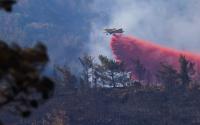 Most of these chicks would not make it through their first year Alexander Kitaysky |
Scientists used lab experiments to mimic changes observed in the diets of kittiwakes in the Bering Sea - changes probably caused by a warming ocean.
Chicks given a diet low in lipid-rich fish were less able to find food.
The RSPB comments that changes in the diets of seabird chicks can affect their chances of survival.
The 1980s saw the start of a decline in populations of red-legged kittiwakes on the Pribilof Islands in the south-eastern Bering Sea, off the coast of Alaska.
Numbers roughly halved over two decades.
The cause has been unclear, though scientists have documented a change in their diet which occurred around the same time.
"With many of the top predators - sea lions, birds - people were talking about drastic population declines," said Alexander Kitaysky from the University of Alaska, one of the scientists on the current study.
"Ecosystems started to change; one of the most pronounced changes was that high-lipid fish such as capelin declined, and were replaced in the kittiwake diet by species such as juvenile pollock which are poor in lipids," he told the BBC News website.
Lab food
 Young kittiwakes learned to associate couloured lids with food |
To investigate what impact a forced switch to a low-lipid regime might have on the development of red-legged kittiwakes, the Kitaysky lab designed experiments to explore the effects of various diets.
Twenty kittiwake chicks were hatched in captivity and assigned randomly to four fish diets: high-volume high-lipid, high-volume low-lipid, low-volume high-lipid, and low-volume low-lipid.
At the age of 47 days, the birds began learning to associate food with containers having lids of various colours.
Those which had been fed a high-lipid diet learned quickly and remembered which containers to go for; those on a low-lipid regime did not learn to discriminate between the various colours.
Alexander Kitaysky believes that in the wild, such an impairment to learn would prove crucial to a bird's survival and its ability to breed and rear offspring.
"Always their food is associated with some signs on the surface or the ocean, whether a change in colour or foam," he said, "and they're supposed to memorise the association.
"Most of these chicks would not make it through their first year."
Lipids are believed to boost the mental development of mammals, including humans; other work in the Kitaysky lab suggests that chicks deprived of lipids show increased levels of stress hormones, which could be behind their mental impairment.
Size matters too
 Red-legged kiitiwakes resting on the Pribilof Islands |
"This study shows that chick nutrition can affect the ability of birds to find food after they fledge in artificial situations," he told the BBC News website.
"However, whether this has contributed to the decline of red-legged kittiwakes in the wild is unclear; the study shows that chicks fed poor quality diets are lighter as well as cognitively impaired, and this could also lower their chances of post-fledging survival."
Around the coast of the UK, some sea bird populations are in catastrophic decline, also due largely to the removal of high-lipid prey such as sand eels. This appears also to be linked with climate change
If anything, they are worse off than the Pribilof kittiwakes, as it appears that the disappearing sand eels are not being replaced by any other species.
The Kitaysky study is reported in the Royal Society's science journal Proceedings B.






